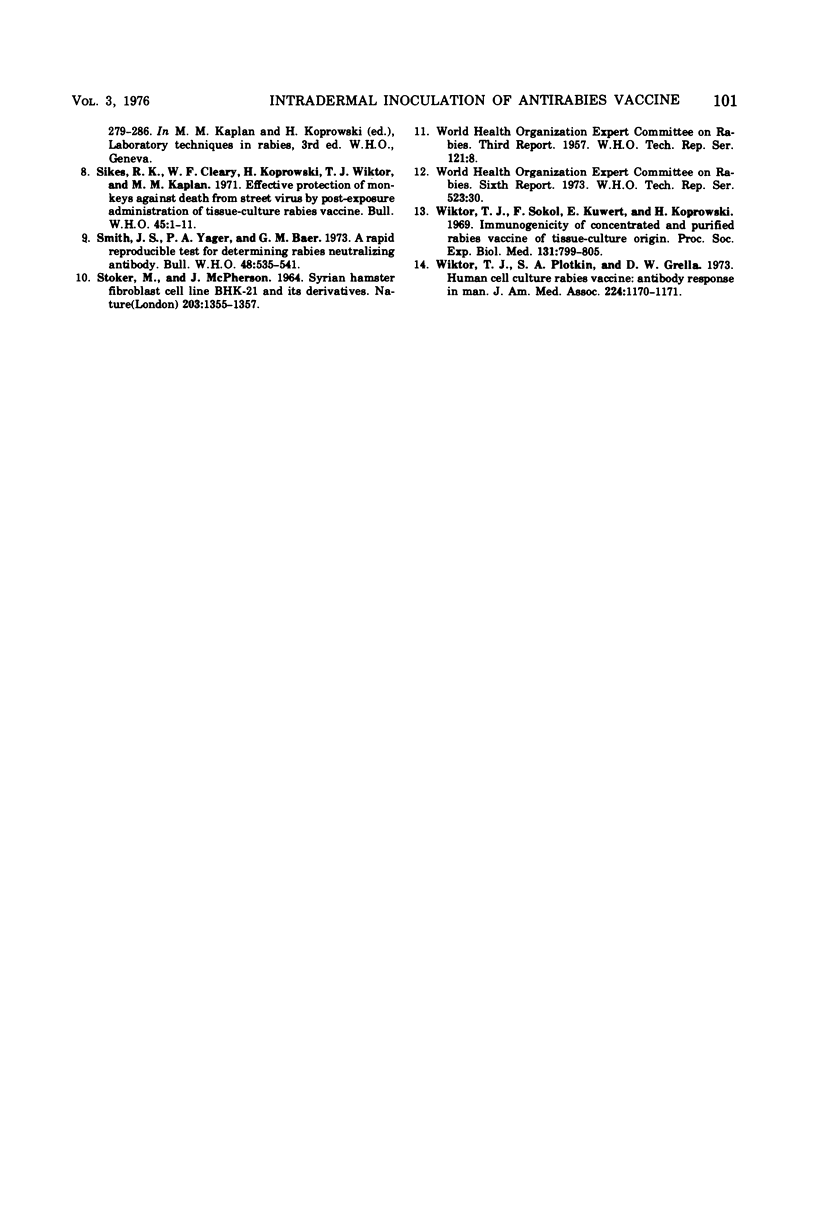Abstract
The antirabies human diploid cell vaccine produced by 1'Institute Merieux, Lyon, France, was administered intradermally to 35 high-risk volunteers using 0.2-ml amounts and various immunization schedules. Three groups never before vaccinated against rabies developed virus-neutralizing antibodies, the titer of which was dose dependent. A single injection stimulated the formation of antibodies. Four inoculations induced the highest antibody levels and the longest persistence of antibody. The administration of a single intradermal booster inoculation was sufficient, even in the case of low-persisting antibody, to elicit a rapid increase of antibodies to high levels. A primary inoculation course of two injections induced a sufficient antibody level which, in case of exposure, could apparently be rapidly elevated by a 0.2-ml intradermal booster inoculation. Adverse side reactions were observed in 7 of 14 individuals after a 1- or 1.5-year intradermal booster inoculation. We therefore suggest that the intramuscular and subcutaneous routes continue to be used for primary vaccinations and that the highly effective intradermal route be restricted to booster inoculations. This is the first long term study of this vaccine and should be a guideline for the pre-exposure treatment of high-risk personnel.
Full text
PDF





Selected References
These references are in PubMed. This may not be the complete list of references from this article.
- Aoki F. Y., Tyrrell D. A., Hill L. E. Immunogenicity and acceptability of a human diploid-cell culture rabies vaccine in volunteers. Lancet. 1975 Mar 22;1(7908):660–662. doi: 10.1016/s0140-6736(75)91761-4. [DOI] [PubMed] [Google Scholar]
- Arko R. J., Wiktor T. J., Sikes R. K. Laboratory techniques in rabies: the antibody binding test for vaccine potency. Monogr Ser World Health Organ. 1973;(23):292–294. [PubMed] [Google Scholar]
- Cabasso V. J., Dobkin M. B., Roby R. E., Hammar A. H. Antibody response to a human diploid cell rabies vaccine. Appl Microbiol. 1974 Mar;27(3):553–561. doi: 10.1128/am.27.3.553-561.1974. [DOI] [PMC free article] [PubMed] [Google Scholar]
- STOKER M., MACPHERSON I. SYRIAN HAMSTER FIBROBLAST CELL LINE BHK21 AND ITS DERIVATIVES. Nature. 1964 Sep 26;203:1355–1357. doi: 10.1038/2031355a0. [DOI] [PubMed] [Google Scholar]
- Schneider L. G., Dietzschold B., Dierks R. E., Matthaeus W., Enzmann P. J., Strohmaier K. Rabies group-specific ribonucleoprotein antigen and a test system for grouping and typing of rhabdoviruses. J Virol. 1973 May;11(5):748–755. doi: 10.1128/jvi.11.5.748-755.1973. [DOI] [PMC free article] [PubMed] [Google Scholar]
- Schneider L. G., Horzinek M., Matheka H. D. Purification of rabies virus from tissue culture. Arch Gesamte Virusforsch. 1971;34(4):351–359. doi: 10.1007/BF01242982. [DOI] [PubMed] [Google Scholar]
- Sikes R. K., Cleary W. F., Koprowski H., Wiktor T. J., Kaplan M. M. Effective protection of monkeys against death from street virus by post-exposure administration of tissue-culture rabies vaccine. Bull World Health Organ. 1971;45(1):1–11. [PMC free article] [PubMed] [Google Scholar]
- Smith J. S., Yager P. A., Baer G. M. A rapid reproducible test for determining rabies neutralizing antibody. Bull World Health Organ. 1973 May;48(5):535–541. [PMC free article] [PubMed] [Google Scholar]
- Wiktor T. J., Plotkin S. A., Grella D. W. Human cell culture rabies vaccine. Antibody response in man. JAMA. 1973 May 21;224(8):1170–1171. [PubMed] [Google Scholar]
- Wiktor T. J., Sokol F., Kuwert E., Koprowski H. Immunogenicity of concentrated and purified rabies vaccine of tissue culture origin. Proc Soc Exp Biol Med. 1969 Jul;131(3):799–805. doi: 10.3181/00379727-131-33981. [DOI] [PubMed] [Google Scholar]


